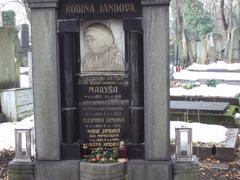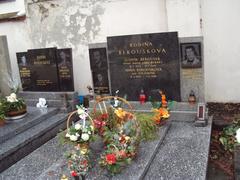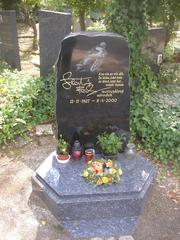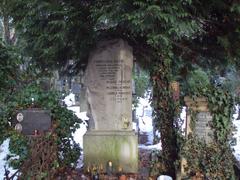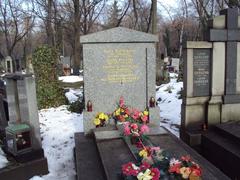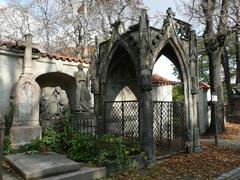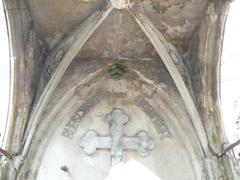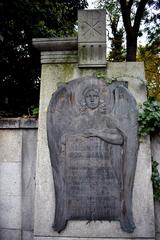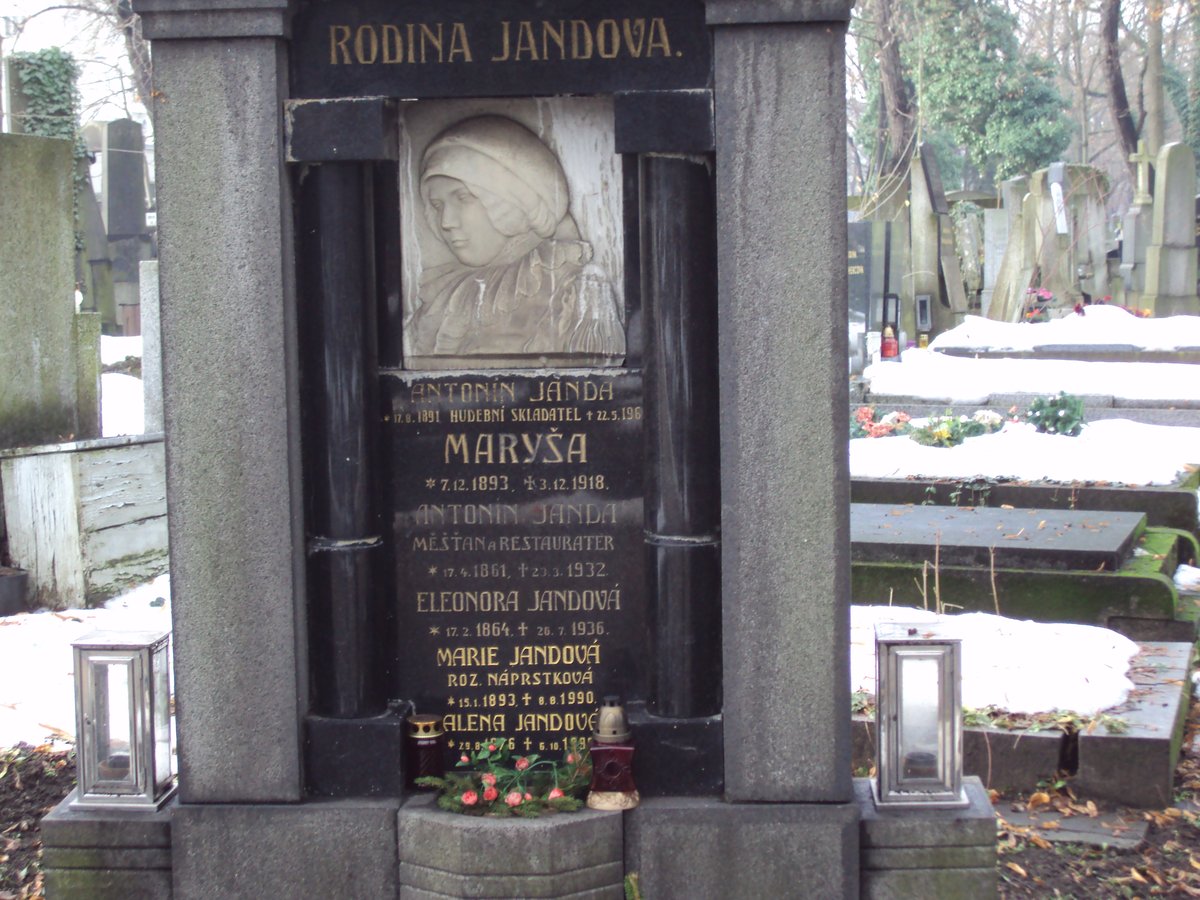
Olšany Cemetery: Visiting Hours, Tickets, and Comprehensive Guide to Prague’s Historic Landmark
Date: 14/06/2025
Introduction: Olšany Cemetery’s Legacy in Prague
Situated in the lively Žižkov district, Olšany Cemetery (Olšanské hřbitovy) is Prague’s largest burial ground and a vivid chronicle of the city’s past. Established in 1680 during a devastating plague, the cemetery was initially created to serve as a burial site outside the city’s confines as churchyards became overwhelmed. Its prominence grew when Emperor Joseph II’s 1787 edict prohibited burials within Prague’s urban core—a progressive move for public health that transformed Olšany into the city’s principal cemetery. Today, the cemetery sprawls across more than 50 hectares, with twelve distinct sections reflecting religious and cultural diversity, including Catholic, Jewish, Orthodox Christian, and Muslim communities. Olšany is a unique cultural landmark, representing centuries of Czech history, artistic trends, and national identity (Spotting History; Prague.eu).
A stroll through Olšany is a journey through an open-air museum of funerary art. Elaborate tombs and monuments—ranging from Baroque to Art Nouveau and Modernist styles—grace the grounds, crafted by artistic luminaries such as Josef Václav Myslbek and Stanislav Sucharda. The cemetery is also the final resting place for prominent figures in Czech literature, politics, music, and science, including Jan Neruda, Jan Palach, and (in the adjacent New Jewish Cemetery) Franz Kafka. Its military sections, honoring soldiers from the Napoleonic Wars through World War II, underscore Prague’s pivotal place in European history (Radio Prague International; CWGC).
This guide offers practical information on visiting hours, tickets, accessibility, notable graves, and tips for making your visit meaningful and respectful. Whether you are drawn by history, art, or quiet reflection, Olšany Cemetery invites visitors to explore Prague’s heritage (Prague Guide; TresBohemes).
Table of Contents
- Origins and Historical Development
- Sections and Layout
- Notable Events and Personalities
- Cultural and Artistic Importance
- Olšany Cemetery’s Role in Czech Memory
- Visiting Information: Hours, Entry, Accessibility
- Visitor Tips and Etiquette
- Frequently Asked Questions (FAQ)
- Related Resources & Articles
- Conclusion
Origins and Historical Development
Olšany Cemetery traces its beginnings to the 1680 plague epidemic, when thousands of victims required burial outside Prague’s walls (Spotting History). The cemetery’s status as the city’s main burial ground was cemented in 1787 by Emperor Joseph II’s reforms, which aimed to improve urban health by banning burials inside city limits. Over time, the cemetery expanded in size and significance, reflecting Prague’s shifting religious and social landscape.
Sections and Layout
Today, Olšany comprises twelve main cemeteries, each with its own character and history. Notable sections include:
- Catholic, Orthodox, and Protestant areas: Showcasing diverse religious traditions.
- The Jewish Cemetery: Located in the eastern part, it is the largest Jewish burial ground in the Czech Republic and includes the grave of Franz Kafka (TresBohemes).
- Military Sections: Dedicated to soldiers from the Napoleonic era through the World Wars.
- Special Sections: Such as the original plague burial site and distinct plots for notable families and artists.
Maps are available at the main entrance and online, assisting visitors as they navigate the winding paths and historical zones.
Notable Events and Personalities
Olšany Cemetery is the final resting place for renowned Czech personalities and commemorates pivotal historical events:
- Writers and Poets: Jan Neruda, Karel Jaromír Erben, Viktor Dyk, Božena Němcová, and more.
- Artists and Musicians: Josef Lada, Jaroslav Ježek, and others whose creativity shaped modern Czech culture.
- Political and Historical Figures: Jan Palach, Klement Gottwald, and Karel Kramář.
- Scientists and Intellectuals: Bernard Bolzano.
- Jewish Section: Franz Kafka and Max Brod are buried in the New Jewish Cemetery.
- Military Graves: Soldiers from the Napoleonic Wars, WWI, WWII, the Soviet Union, and Allied armies (CWGC).
Monuments also honor victims of epidemics and significant national tragedies.
Cultural and Artistic Importance
Olšany’s grounds are adorned with masterworks of funerary art. The cemetery is a showcase for stylistic trends from Baroque to Cubism and Modernism, with sculptures and chapels created by artists such as Josef Václav Myslbek, Stanislav Sucharda, and Ladislav Šaloun (Prague City Tourism). The Jewish Section features traditional Hebrew symbols, and the multicultural areas highlight Prague’s cosmopolitan history.
Literature and cinema have drawn inspiration from Olšany, with appearances in works by Franz Kafka and Jaroslav Hašek and films like “Kolya” and “The Cremator” (Czech Film Commission).
Olšany Cemetery’s Role in Czech Memory
The cemetery is a focal point for national remembrance, especially on All Souls’ Day (Dušičky), when thousands light candles and honor their ancestors (Radio Prague International). Annual commemorations and public events further reinforce Olšany’s role as a keeper of Czech identity and collective memory.
Visiting Information: Hours, Entry, Accessibility
Hours
- April–October: 8:00 AM – 6:00 PM
- November–March: 8:00 AM – 4:00 PM
- Hours may be altered on public holidays; always check official sources before your visit.
Tickets & Fees
- Entry: Free for individuals.
- Guided Tours & Special Exhibits: May require a ticket or small fee; inquire at the visitor center or through Prague tourism websites.
Accessibility
- Transport: Easily reached via tram (lines 5, 9, 10, 16, 26, and 53) and near Flora metro station (Line A). Main entrance: Vinohradská 153.
- Paths: Paved and generally accessible for wheelchairs and strollers. Some older areas may have uneven terrain.
- Facilities: Restrooms, benches, maps, and a small visitor center are available.
Guided Tours and Special Events
- Regular guided tours highlight history, art, and notable graves. Tours are often available in several languages.
- Special events take place during national holidays, All Souls’ Day, and anniversaries.
Getting There and Nearby Attractions
- Located in Prague 3, Žižkov district.
- Combine your visit with nearby sites: Žižkov Television Tower, Vítkov National Monument, and vibrant local cafés.
Photography
- Photography for personal use is allowed. Be discreet around mourners; some restrictions may apply in the Jewish section.
Visitor Tips and Etiquette
- Dress modestly and behave respectfully (The Invisible Tourist).
- Maintain a quiet demeanor—avoid loud conversations or music.
- Stay on marked paths to protect graves and ensure safety.
- Be mindful of security: Keep valuables secure, especially near entrances.
- Pets: Not allowed, except for service animals.
- Best time to visit: Early morning or late afternoon for tranquil ambiance and ideal lighting.
Frequently Asked Questions (FAQ)
What are the opening hours?
- 8:00 AM–6:00 PM (April–October), 8:00 AM–4:00 PM (November–March).
Is there an entrance fee?
- No; entry is free. Some tours or special events may require tickets.
Are guided tours available?
- Yes, in Czech and English. Check with the visitor center or online.
Is the cemetery wheelchair accessible?
- Main paths are accessible; some historic sections may be uneven.
How do I reach Olšany Cemetery?
- By tram (lines 5, 9, 10, 16, 26, 53) to “Olšanské hřbitovy” or Flora metro station (Line A).
Are there special events?
- Yes, especially on All Souls’ Day and during public commemorations.
Related Resources & Articles
- Spotting History: Olšany Cemetery
- Prague.eu: Olšany Cemetery
- Prague Guide: Olšany Cemeteries
- TresBohemes: Prague’s Important Cemeteries
- Radio Prague International: Resting Place of Czech Greats
- CWGC: Olšany Cemetery Details
Conclusion
Olšany Cemetery is much more than a resting place—it is a living monument to Prague’s rich history, diverse culture, and enduring artistic legacy. Its tranquil avenues, remarkable funerary art, and the stories of those interred within its grounds make it an essential destination for anyone seeking to connect with the heart of Czech national identity.
To enrich your visit, use interactive maps, virtual tours, and audio guides like the Audiala app. For event updates and in-depth information, follow official Prague tourism platforms. Whether you are a history enthusiast, lover of art, or simply in search of a reflective urban retreat, Olšany Cemetery welcomes you to discover Prague’s soul.
References and Further Reading
- Olšany Cemetery Visiting Hours, Tickets, and Historical Guide (Spotting History)
- Olšany Cemetery Prague: Visiting Hours, Tickets, History & Cultural Significance (Prague.eu)
- Olšany Cemetery in Prague: Visiting Hours, Tickets, and Notable Graves (Prague Guide)
- Olšany Cemetery Visiting Hours, Tickets & Guide (TresBohemes)
- Olšany Cemetery - Resting Place of Czech Greats (Radio Prague International)
- Olšany Cemetery Details (CWGC)
